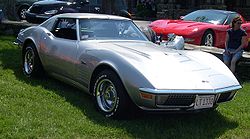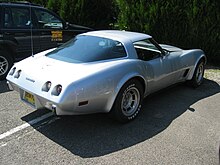Corvette C3
| Chevrolet | |
|---|---|
|
Chevrolet Corvette C3 Coupé (1967-1976)
|
|
| Corvette C3 | |
| Production period: | 1967-1982 |
| Class : | Sports car |
| Body versions : | Coupé , convertible |
| Engines: |
Petrol engines : 5.3–7.4 liters (121–320 kW) |
| Length: | 4640 mm |
| Width: | 1750 mm |
| Height: | 1210 mm |
| Wheelbase : | 2490 mm |
| Empty weight : | 1410 kg |
| Previous model | Corvette C2 |
| successor | Corvette C4 |
The Corvette C3 was introduced in the fall of 1967 as the third Corvette generation, which was built until the fall of 1982. It was also called Stingray (English: Stingray ) from 1969 to 1976 , which was also shown as a lettering on the body. The C3 was very successful despite initial processing problems. In contrast, construction of the convertible ended at the end of 1975 due to stricter safety regulations.
history
The new generation was characterized by a completely new design of both the interior and the body. The eye-catching body design went down in car history as the “ Coke Bottle Corvette ”. The wheelbase and large parts of the chassis were taken over from the C2. From 1968, the fold-out main headlights were no longer moved electrically, but pneumatically. The coupés were equipped with two removable roof halves ( T-Top ) and a removable rear window.
Concepts
The design of the C3 by David Holl is strongly of the concept car Mako Shark II show car (English: Mako shark ) inspired from 1965, which itself numerous elements of the 1954 by Bertone designed Arnolt-Bristol quoted. The "Mako Shark II" (project designation XP-830) was first presented to the public in April 1965 at the " New York International Auto Show " as a design study . The cost of developing this non-drivable prototype was nearly $ 3 million. The “Mako Shark II” had its second debut at the “ Paris Motor Show ” on October 5, 1965. This time, however, it was equipped and ready to drive with an engine with a displacement of 7.0 liters (427 in 3 ) and eight cylinders. This car was ultimately the basis for the new "Stingray".
With numerous futuristic details such as a rectangular steering wheel, an extendable rear spoiler or a bumper that could be extended for improved protection, the two “Mako Shark II” concept cars caused a sensation in 1965, but these ideas were not taken into series production. The strongly curved body line of the show cars, on the other hand, was taken over by Corvette designer David Holls for the third generation.
production
Production started in September 1967.
In 1981, the second time after December 1953 was the move: Production was relocated from St. Louis / Missouri to Bowling Green / Kentucky , i.e. to the factory where the Corvette still rolls off the assembly line today. The parallel production of the C3 models in June and July 1981 was unusual. During these two months, the plain-colored versions were produced in St. Louis, while the two-tone versions were produced in Bowling Green.
Production ran until October 1982. A total of 542,861 Corvette C3s were built, including 70,586 convertibles, which were only built from 1967 to 1975. With almost 543,000 models built in 15 years, the C3 builds on the successes of its predecessors. The best year of production in the history of the Corvette at all, 1979 with exactly 53,807 units (after 46,776 units in 1978), falls into the era of the C3 Corvette. This model was relatively stable until 1981 (40,606 units), but in the last model year, 1982, production fell to 25,407 units. From 1982 onwards, the C3 had no chance against its European and Japanese competition. That should be changed from 1983 with the successor model Corvette C4 .
body
The Corvette C3 looks much more massive than its predecessor. The body was 190 mm longer and had now grown to 4.64 meters, while the wheelbase and width remained the same. The height was again 50 mm lower than that of the C2 and was only 1.21 meters. The C3 is also known as the “ Coke-bottle-shape Corvette” due to its striking fender curve, as the side profile looks similar to a Coca-Cola bottle. The distinctive design or elements of it were often copied by other automobile manufacturers.
Sections of the trade press criticized the fact that the design of the new model had put practical concerns into the background as opposed to aesthetic gimmicks. For example, the windshield wipers hidden under a retractable cover, which were unsuitable for areas that were not frost-proof, were also criticized. There were also significant problems with the engine cooling system; It was only shortly before the start of production that the front apron received additional cooling air openings and a spoiler lip below the bumper. The processing quality was also not the best; the US magazine "Car and Driver" returned a test car to the factory untested in 1967 because it had a long list of quality defects.
From 1969 to 1976 the “Stingray” lettering appeared on the front fender, but in one word - in contrast to the C2, in which the designation was written as “Sting Ray”.
As an absolute novelty in production cars, the Corvette was equipped for the first time with two removable roof halves, after which a central bar remains, which is also known as the "T-Bar-Roof" or " T-Top ". Even the vertical rear window can be removed from the models from the first five years of production. It was retained as a stylistic feature until 1977, from 1978 onwards, as part of a major facelift, the Corvette received a fastback rear with a large glass dome behind the B-pillar.
The safety discussion in the mid-1970s not only led to hectic changes to the bumpers, the 73 model, for example, has a curious mix of plastic bumpers painted in body color at the front and classic chrome copies at the rear. It also means the temporary end for the open versions.
Due to stricter safety regulations in the USA, the convertible was only offered until the end of 1975, after which it disappeared from the range. Until production was discontinued in October 1982, only the coupé was available.
In order to comply with the new regulations on impact protection up to 5 mph, the Corvette was given a front bumper made of polyurethane for the 1973 model year , while the conventional chrome bumper remained at the rear, but was replaced in the following model year by a PU bumper that was only split in the middle in 1974 .
landing gear
The two-stage automatic transmission "Powerglide" from the C2 had had its day and was replaced by the new automatic transmission "Turbo Hydra-Matic" with three stages.
The engineers at General Motors once again demonstrated their enthusiasm for innovation in the chassis area, but only in the penultimate model year of the Corvette C3. The transverse leaf springs on the rear axle were made of glass fiber reinforced plastic from 1981 . The advantages lie in the weight of only around four kilograms, the avoidance of rust formation and a five times longer shelf life.
engine
Starting in 1968, the basic engine version was the 5.3-liter "small block" eight-cylinder engine known from the C1 and C2, with an output of 300 hp (221 kW). The 7.0-liter “big block” engine with outputs from 390 hp (287 kW) to 435 hp (320 kW) was also available again.
The hunt for the largest displacement and the highest performance reached its absolute climax in 1971. The “big block” of a Corvette was never larger than between 1970 and 1974: 7.4 liters displacement results in a volume of over 930 cm³ per cylinder. In 1971, 320 kW (435 hp) marked the hitherto highest output of a production version in the history of the American sports car legend, even though the compression was reduced in this model year.
Until 1971, the Corvette could be ordered with engines up to 320 kW (435 US gross SAE PS ), from 1972 the oil prices and the dramatically increased insurance premiums for high-performance vehicles were reflected in a reduction in the maximum output to 270 bhp, a basic Corvette had only 200 bhp. At the end of its construction period, the C3 could still mobilize a maximum of 230 bhp.
The "ZL1" engine, which was officially ordered by only two customers in 1970, is worth mentioning. A red Corvette Coupé was built by engineer Gib Hufstader for drag racing. The car completed the quarter mile in 10.6 seconds at a top speed of 132 mph (212 km / h). The second car was a white convertible, which chief engineer Zora Duntov designed for street races. This car reached a top speed of 200 mph (321 km / h). According to the brochure, the engine achieved 430 bhp, five less than the "strongest" engine. Basically, however, the ZL1 was an "L88" engine with an aluminum block, modified engine parts and around 585 SAE horsepower . There were smoothed exhaust ducts and other valves. The engine had a compression of 11.45: 1. The engine allowed the use of Holley 4500 NASCAR carburetors with a mixture throughput of 1200-1400 cfm (cubic feet per minute). This corresponds to around 2040–2380 m 3 / h. The driver John Greenwood achieved numerous racing victories including the championship title of the SCCA.
This standard motor could also be ordered in the previous C2 model from 1967.
With the lower power rating, General Motors wanted to prevent this monster from getting into the hands of people who simply choose the most powerful engine in the brochure. Regardless of whether the ZL1 or the “normal” L88, GM did not give the wrong output, but only gave a value that was realized at a lower speed. Also, nowhere in the sales brochures was it stated that the L88 could achieve significantly higher speeds in order to develop its additional performance. In a brochure, Chevrolet also warned against using the Corvette with the ZL1 option as a road vehicle.
For 39 years, until the appearance of the C6 ZR1, the ZL1 was considered the fastest and most powerful series Corvette of all time. The performance of US vehicles was given in America with gross SAE HP until 1972 . These SAE-PS performance data are considerably higher than the DIN-PS data due to different measurement methods . For this reason, such performance data for US vehicles before 1972 should be treated with appropriate caution, as add-on units such as generator, water pump and fan were omitted during the measurement.
Web links
Individual evidence
- ↑ John Gunnell (1947-): Standard guide to American muscle cars: [a supercar source book, 1960-2005] . 4th edition. KP Books, Iola, Wis. 2005, ISBN 0-87349-988-3 (English).





